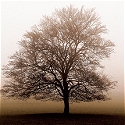|
Transcendance and Immanence
The idea of the sefirot (ūĪų░ūżų┤ūÖū©ūĢų╣ū¬, "enumerations") is the defining metaphor of Kabbalistic pantheism. The earliest reference is found in Sefer Yetzirah (The Book of Formation), where the ten Sefirot and the twenty two letters of the Hebrew alphabet was said to comprise the "thirty-two paths of wisdom" through which God created the world. The ten sefirot are considered the attributes of God, the archetypes of creation, or the primary values of the world. They are sometimes depicted as (concentric) "emanations" of the divine attributes of God, such as illustrated in this diagram:
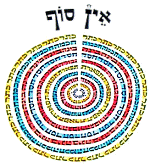
The ten sefirot can be thought of as ten (interdependent) creative forces (logoi) that intervene between the infinite, unknowable God (Ein Sof) and the created world. They are said to be "one" with Ein Sof, like a flame is one with the fire. Through these emanations God created the universe, and it is by influencing them that humans cause God to send to Earth forces of compassion (masculine, right side) or severe judgment (feminine, left side).
The sefirot "reveal the concealed" aspects of Infinity and are thought to represent the "unfolding" of the Divine Personality (nous) in the universe. God's actions only reveal His will, not His nature or essence... We can only know God through analogy, and religious language is therefore anthropomorphic. We can say what God's nature is not, but never what it truly is (this is sometimes called "via negativa"). Only God knows Himself, but we can come to understand God through metaphor and analogy. That's the basic rationale for the metaphor of the sefirot, which is sometimes depicted as Etz haChayim (ūóūź ūöūŚūÖūÖūØ), the "Tree of Life."
The Tree of Life Metaphor
The Sefirot were often depicted as a series of concentric circles (beginning with Keter as the outermost and ending with Malchut as the innermost circle). Sometimes they are pictured as a "Tree of Life" to illustrate the process by which the Universe came into being:
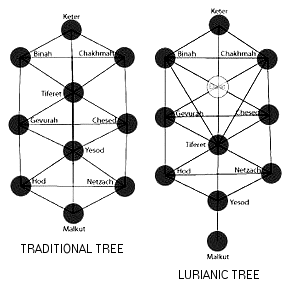
The Ten Sefirot are:
- Keter - Crown; Divine Plan; God's Self-Consciousness
- Chokhmah - Wisdom;
- Binah - Understanding; revelation as outworking of love
- Chesed - Kindness; everlasting love
- Gevurah - Strength; intentionality
- Tiferet - Beauty in the universe
- Netzach - Victory; resurrection
- Hod - Awe; surrender
- Yesod - Foundation; 1st principles of human knowledge
- Malkhut - Kingdom; physical revelation in space-time
Note: Lurianic Kabbalah considers the sefirah Keter as incommunicable and therefore does not count it as one of the sefirot. Instead, the sefirah of Da'at (knowledge) is inserted between Binah and Chesed to retain a total of 10 sefirot. In English, the traditional Tree can be represented as follows:
Keter: the Starting Point
The very first "emanation" -- the transition from Ein Sof to the revealed world -- is shrouded in mystery. This is the move from the realm of the absolutely infinite to the realm of the finite. Though it is beyond comprehension, the Kabbalah identifies this with the will of God. That is, the root of all of creation is found in God's will to create. God's will - alone - is the ground of all reality. Metaphorically, this is depicted with the image of a crown of a King and is called the sefirah of Keter (ūøų╝ųČū¬ųČū©). Keter, then, represents the transition from Ayin (nothing) to Yesh (something), and therefore creation ex nihilo ("out of nothing") is called yesh me'ayin. Keter represents the hidden or secret will of God and answers the question, "Why is there something, rather than nothing?" The answer is simply because "it" is the will of God (what else can be said?). The Name of God associated with Keter is Ehyeh (ūÉųČūöų░ūÖųČūö), "I AM," though Keter is also sometimes called Ayin (ūÉųĘūÖų┤ū¤, Nothingness) and Ratzon (Will). Hence the first of the sefirot (attributes) is called Keter, which is usually regarded as a synonym for the Infinite One (Ein Sof) itself. Here is another sketch of this idea:
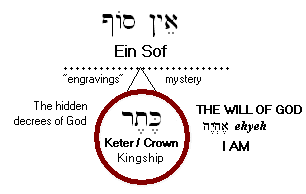 |
Note that there is profound mystery connected to all of this. The transition from the infinite to the finite is beyond all our comprehension. We simply cannot know how or why God chose to create, only that it was His will or desire to do so. Note also that Keter, as the first of the sefirot, is considered the "root" of all that follows. It is the primordial energy (Divine Light) out of which all things are created. Within the Divine Will are the "blueprints," "engravings," "seeds," or "DNA" for the rest of creation. Keter is the most basic of the Divine Attributes, though it is essentially beyond our ability to fathom. The Zohar states that we can only say once positive thing about Ein Sof -- that it made "engravings" in infinite purity called "Keter." From these "engravings" God's attributes begin to be revealed, beginning with the attribute of chokhmah (ūŚųĖūøų░ū×ųĖūö) - wisdom.
Chokhmah: the Divine Mind / Father
The sefirah (attribute) of Chokhmah (ūŚųĖūøų░ū×ųĖūö), "Wisdom," represents the beginning of God's self-conscious mind (nous) within creation. Chokhmah is the first sefirah on the right (i.e., masculine) side of the Tree of Life. The Zohar interprets Job 28:12 ("From whence (me'ayin, ū×ųĄūÉųĘūÖų┤ū¤) shall wisdom (ūŚųĖūøų░ū×ųĖūö) be found?") to mean literally from Ayin (ūÉųĘūÖų┤ū¤) is wisdom derived. In other words, Chokhmah "flows from" Keter as God's first revealed attribute beyond His brute will to create. Here is another depiction of this idea:
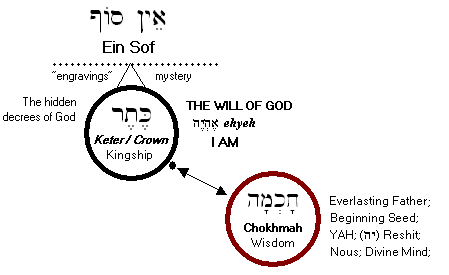 |
Chokhmah is also regarded as the "Father of Yesh" and the "seed" for all the other sefirot. The Zohar also links the phrase "reshit chokhmah" (ū©ųĄūÉū®ūüų┤ūÖū¬ ūŚųĖūøų░ū×ųĖūö) found in Psalm 111:10, with Genesis 1:1, "In the beginning created Elohim" (ūæų╝ų░ū©ųĄūÉū®ūüų┤ūÖū¬ ūæų╝ųĖū©ųĖūÉ ūÉų▒ū£ūöų┤ūÖūØ), to derive the idea that "with Chokhmah Keter created Elohim." In other words, Elohim is considered a direct object of the verb bara, with the implied subject of Keter (or Ein Sof). Ein Sof is not explicitly mentioned as the subject of Genesis 1:1 because the Infinite is beyond predication.
The Name of God associated with Chokhmah is YAH (ūÖųĖūöų╝), a shortened form of YHVH (ūÖūöūĢūö). These first two letters (ūÖūö) are said to refer to the "concealed dimension" of YHVH (as opposed to the last two letters (ūĢūö) that refer to YHVH's "revealed dimension"). The Name YAH therefore suggests that the Divine Wisdom is essentially unfathomable to the mind of man. Chokhmah represents the Father of Creation, the Divine Mind and Source of all wisdom. This attribute of Ein Sof is further depicted as the "Divine Seed" that "impregnates" the next sefirah called Binah ("understanding"). From the union of Wisdom and Understanding will flow all the other sefirot which are metaphorically regarded as "children."
Binah: the Divine Womb / Mother
The third sefirah is Binah (ūæų╝ų┤ūÖūĀų╝ųĖūö), a word often translated as "understanding." Binah is the first sefirah on the left (i.e., feminine) side of the Tree of Life. Binah is said to give a "garment" to Chokhmah, or to give form to the creative power and wisdom of God. Because of this, Binah is associated with Divine Reason in the sense of accommodating or giving expression to the to divine Wisdom. Binah gives definition to the first principles of wisdom, differentiating them into specific entities (the word bein, "between" is related to binah). Binah is also regarded as the "feminine" counterpart to the masculine Chokhmah, and is therefore likened to a womb or spouse. And since the following sefirot all descend from Binah, this attribute is regarded as the Divine Mother aspect of God. "Wisdom (chokhmah) has built (bana) a house (binah), she (binah) has hewn out her seven pillars" (Prov. 9:1).
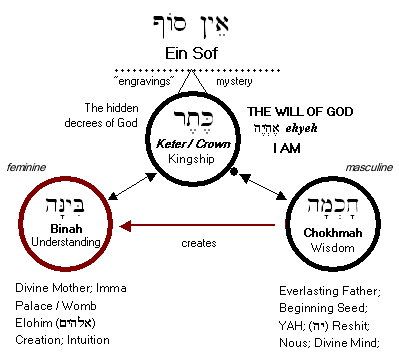 |
The combination of Keter, Chokhmah, and Binah marks the first "Trinity" of the Godhead, and is sometimes referred to as the "upper face" of the Tree of Life. From a Messianic perspective, Keter (Ein Sof) represents the Father; Chokhmah represents the Son, and Binah represents the Ruach HaKodesh (Holy Spirit). There is a gap between the first triad and the second (explained below). This is the "Abyss" that represents "our side," or that which is closer to human experience in creation.
The Talmud and the word "Bereshit"
Regarding the Hebrew word bereshit (ūæų╝ų░ū©ųĄūÉū®ūüų┤ūÖū¬), the Talmud states that King Ptolemy of Egypt gathered 72 sages and placed them in 72 chambers without telling them why he brought them together. The legend has it that he went to each sage and told him: "Translate for me the Torah of your master Moses into Greek." (This ancient Greek translation was later known as "translation of the Seventy" (i.e., ū¬ų╝ųĘū©ų░ūÆų╝ūĢų╝ūØ ūöųĘū®ų╝ūüų┤ūæų░ūóų┤ūÖūØ) or the "Septuagint"). God then prompted each sage to translate the Torah in precisely the same way. For example, the sages all rendered bereshit bara Elohim in Greek as, "God created in the beginning" (ß╝É╬Į ß╝ĆŽüŽćß┐ć ß╝ÉŽĆ╬┐ßĮĘ╬ĘŽā╬Ą╬Į ßĮü ╬Ė╬ĄßĮĖŽé) instead of the more literal, "In the beginning created God." The Talmud claims that God prompted the sages to translate this way in order to prevent Ptolemy from thinking that God (ūÉų▒ū£ūöų┤ūÖūØ) was created by a spearate being named "in the beginning" (i.e., bereshit).
The Zohar and the word "Bereshit"
According to the Zohar, one of the names of God associated with the attribute of Binah is Elohim (ūÉų▒ū£ūöų┤ūÖūØ). To give you some idea of how this affects the reading of the Scriptures, consider the very first verse of the Bible: "In the beginning God created the heavens and the earth." The first word of this verse, bereshit (usually translated as "in the beginning") is translated as "with reshit," which (based on an equivalence between reshit (ū©ųĄūÉū®ūüų┤ūÖū¬) and wisdom (ūŚųĖūøų░ū×ųĖūö) given in Psalm 111:10) is said to mean "with the attribute of wisdom." Thus we have, "With [the attribute of] wisdom created God." But note that the Kabbalist interprets the word "God" (Elohim-Binah) as a direct object here, and not as the subject of the verb. This gives us, "With [the attribute of] wisdom created [the attribute of] understanding." But who/what is the subject of the verb "created"? The Zohar goes on to say that the implied (and inexpressible) subject is actually Keter (or Ein Sof), so the clause comes to mean: "With [the attribute of] wisdom Ein Sof created [the attribute of] understanding" (or "With Chokhmah Ein Sof created Binah"). Here is a diagram of the first clause of the verse:
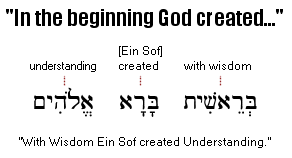 |
Now what is ironic about all this is that the Kabbalists do precisely what the Talmud claims was expressly forbidden by God. According to the Zohar, the word Elohim is to be understood as a direct object, not as the subject of the verb bara. Thus the Kabbalists maintain that "In the beginning God created..." should be translated as "with wisdom Ein Sof (the unexpressed subject of the verb) created Elohim. It should be clear that this is a classic example of "reading into" the text ideas that simply are not present.
|

